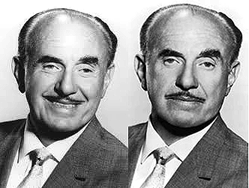Moguls & Studios: Part I
Before I get into the meat of yet another series, quick congratulations to the Toronto Underground Cinema, which is a year old.
I interviewed co-owner Charlie Lawton prior to the cinema’s grand opening in 2010, and it bodes well that the city continues to enjoy a diverse group of indie cinemas that are giving cineastes what they want without ersatz IMAX-ish screens, re-rendered 3D engagements, and charging admissions a few hairs below $20 smackaroons.
I think the studios were salivating over the potential of prices cresting into the $20+ range this year, but that hasn’t happened… yet.
Moving on, I’ve uploaded a review of TCM’s Moguls & Movie Stars: A History of Hollywood [M] (Warner Home Video) which provides one of the best overviews of the industry town’s development, particularly for mid-level and newcomers to film history.
I still find it ironic that the total vertical integration model could never be quashed by the U.S. Government. In the forties, studios were slammed for block-booking and later told to divest themselves of their theatre chains in the forties (aka the Paramount Decree), but by 2011 the companies have evolved into the convergence models dreamed up by their founders; they don’t own talent agencies nor groom their own stable of above-the-line talent anymore, but in terms of production, from the point of pre-production seed money to the Blu-ray / DVD you’re watching right now, it’s all one fluid system.
One theme that comes up in the series’ finale, and raised again in the related panel discussion on the DVD set, is Hollywood’s predictable response to Something New – which isn’t exclusive to the mogul mentality.
Fear came from free radio shows, sound films, widescreen processes, Technicolor, free TV, pay TV, home video, DVD, and digital technologies, resulting in a knee-jerk reaction that ‘it’s all going to kill the movies as we know it.’
Series writer / producer Jon Wilkman makes a sharp little point in the DVD set’s last panel discussion: the various trends and challenges over the past decades have brought the industry full circle to a point no one quite expected.
Moguls & Movie Stars begins with stills of curious people looking at stereoscopic photos through a viewer, and maybe 100 years later that personal relationship with media is back, akin to you holding up an iPhone or any smart phone, and looking at media. It’s gone from images held in front of you to movie palaces and grand audio-visual experiences, and now people are comfy watching media whenever and however they want – and that lack of control scares the establishment.
It’s not knowing what you want, how you want to see it, and what to charge. Should it come with a digital copy, or should you be able to download the file from a studio server with an access code? What should be the final price? Will there be user fees? Expiration dates? And what will our viewing behaviour be like 2 years from now?
Behaviour and technology go hand in hand, because they feed off each other. We need something better or less annoying, and along comes a solution. The problem is sort of like the old axiom where four other screenwriters are working on the same idea you’re pounding out on the keyboard; many talented minds are trying to figure out ways to make things better and faster for themselves, and the solutions sometimes run contrary to issues of ownership when those ideas go mainstream.
Wilkman’s series is both a fun history lesson and a stealth cautionary note to the establishment to learn from the past and adapt instead of quash threats, because history has shown some of the biggest perceived challenges opened up substantive income streams; only a few practical minds recognized that selling product to TV and producing original content for multimedia platforms was a good thing.
Walt Disney didn’t have a massive studio in the fifties, but he had a back catalogue of titles and characters he could exploit in movies and TV, and moving production to the Idiot Box probably saved the company because it pushed its product into the living rooms of families, and fostered the Disney brand – from movies, music, shows and toys and a merchandising empire unequaled by anyone, including George Lucas.
(Of course, I could raise the issue of the Disney empire lobbying successfully to extend the copyright law from 50 to 70 years after a creator’s death, but that just creates an upset tummy, whichever way one leans.)
Moguls & Movie Stars marks the first of another ongoing series here about movie moguls and studios, and if you read the review, you’ll find at the end a series of titles – biographies, documentaries – also of note, some of which I’ll cover now and then with references to extant books worth snapping up.
Incidentally, the best series on the studios, incidentally, was published more than 20 years ago in a large coffee table size by Octopus Books. Each volume contains a detailed preface on a studio’s founding, and chapters that assembled films produced and also released by said studio per decade. The films are accompanied by a photo, and a concise yet compelling synopsis. Each chapter includes a decades highlights preface, and the indexes offer title and personnel searches.
Awesome series for bibliophiles which spanned Columbia, Disney, MGM, Paramount, RKO, United Artists, Universal, and Warner Bros. A rival publisher stole some thunder with their own tome on Twentieth Century-Fox, but it’s a tepid effort.
.
.
Mark R. Hasan, Editor
KQEK.com
Category: EDITOR'S BLOG, FILM REVIEWS






Connect
Connect with us on the following social media platforms.